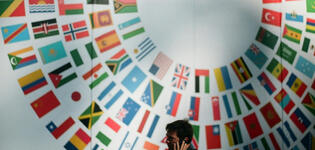Blog
From billions to trillions – can the international financing for development system deliver this?
It is surreal, sitting on this side of history. Many who were involved in shaping the 2030 global development agenda recall the intense process and the renewed optimism sparked by collective action, especially with the adoption of controversial goals like SDG 16: Peace, justice and strong institutions. Yet, as 2030 approaches, we are off track in achieving the SDGs, facing an estimated annual shortfall of USD 4 trillion in necessary financing.
This figure doesn’t even include the climate financing gap of an additional USD 2–3 trillion. We are also grappling with multiple complex challenges, barely having survived the pandemic; only to wake up to a world that is more unequal and deeply divided. The poor and vulnerable are worse off, the richest few have doubled their wealth, trust is scarce, solidarity is low, diplomatic efforts to end wars are failing, and as new crises emerge, many others are forgotten.
The multilateral system now stands in the court of public opinion. Geopolitical tensions, frustrations with perceived double standards, and a system that seems to leave the majority behind threaten to undermine the very framework that could mobilize collective action for shared prosperity and peace. In a climate of apathy and distrust toward multilateralism, it’s becoming clear that the economic are political and the political increasingly economic. Addressing global economic governance and the international financial architecture is both a political and an economic technical challenge, requiring convergence on common understanding and shared aspirations. The UN remains the central arena for these critical political discussions and is pivotal to rebuilding trust.
The call by the US Secretary of State to reform MDBs in 2022 with a rallying cry, ‘We need to move from billions to trillions’, highlights the urgency. But are we really? and how? Every multilateral and plurilateral process and conversation taking place now bears a big responsibility and probably the most critical one of our time, to unlock all the valves of the global financing system that will deliver this financial ambition. The UN has a critical role to play in galvanizing the political push to achieve this.
So, what does the political system need to understand to send the right signals about where these trillions will come from? Let’s explore the four major sources that I see, along with one that lies outside the ambit of multilateral decision-making:
Official Development Assistance (ODA)
There’s the now age-old commitment that OECD DAC donors made to allocate 0.7% of their Gross National Income (GNI) to ODA. This has not been met several decades later. In 2023, ODA increased in overall numbers, to USD 223.7 billion, representing 0.37% of their combined GNI. If we were to achieve the 0.7%, that would mean doubling ODA to USD 500 billion. This translates to 12.5% of the shortfall. Whilst DAC ministries of foreign affairs are confronted with these demands, their ministries of finance are more preoccupied with internal domestic pressures, including balancing macroeconomic fundamentals, building artillery stocks, and responding to their own constituencies. The two need to converge in understanding that development cooperation is critical for the stability and sustenance of all of humanity and is not optional.
Multilateral Development Banks (MDBs)
The 2022 G20 independent review of the Capital Adequacy Framework of MDBs, recommended actions for MDBs, including looking creatively at their balance sheets, appropriately valuing callable capital and preferred creditor status, adjusting leverage ratios, amongst other capital optimization measures. The independent team of experts estimated that these actions could increase available financing by USD 1 trillion. In 2023, however, the MDBs announced that the steps they could take within the constraints of maintaining their AAA credit rating would yield about USD 258.5 billion over the next decade (or around USD 25.9 billion per year).
In the wake of the increasing challenges faced by low-income countries, MDBs will remain a critical source of increased concessional financing. It is incumbent upon the shareholders to do more. The World Bank president put it very aptly while speaking about IDA, in saying, ‘…no amount of creative financial engineering will compensate for the fact that we need more funding’. MDBs have a compelling business model, leveraging USD 4 for every USD 1 invested due to their AAA credit rating. Considering competing demands for resources, any opportunity to stretch a dollar of financing sounds like smart business. Sufficiently capitalizing MDBs, especially regional MDBs, should be a simple business case to make for the ministries of finance of shareholder countries. Ministries of foreign affairs and heads of government, need to understand how MDBs are capitalized, to motivate this decision.
Domestic revenue mobilization and stemming illicit financial flows (IFFs)
Low-income countries are really challenged when it comes to their own domestic resource mobilization. At present, average tax revenues are 13.8% of GDP in LICs, 19.75% in MICs, and 32.5% in HICs. Tax competition to attract direct foreign investment has led to a continuous decline of tax rates in many countries. Regarding IFFs, the UN Financial Accountability Transparency and Integrity Panel Report (2021) on IFFs highlighted that countries are losing USD 500 to USD 650 billions of tax revenues from profit shifting and base erosion of corporations and private wealth hidden in tax havens. Another 2.7% of global GDP is laundered by criminals and global corruption accounts for USD 1.5–2 trillion annually. A back-of-the-envelope calculation reveals that sealing these leakages could easily unlock USD 3 trillion annually. Any reform of the international financial system that can close these loopholes would go a long way to closing today’s financing gap. This will require not just technical pundits negotiating endlessly about technicalities, it will require a political decision that is determined to produce results.
Cost of debt
This is not so much a source of finance, but a savings that can reduce demand for international development finance. Over 50% of countries that use the joint IMF-World Bank Debt Sustainability Framework for Low-income Countries, are currently assessed as at high risk of debt distress or in debt distress. Around 40% of the global population live in countries where government spending on interest payments exceeds spending on education and health.
Some low-income countries are spending as much as 22% of their revenues on interest payments alone—4 times what they were spending 10 years ago. UNCTAD also estimates that African countries borrow at rates that are four times higher than those of the United States and eight times higher than those of Germany. ONE, in their recent report, projects net outflows of USD 50 billion from developing countries in 2024. In other words, low-income countries will pay more to service their debts than they receive in aid financing. Addressing the cost of debt for poor countries cannot be left only to a self-correcting mechanism that is indifferent to the multi-dimensional challenges that low-income countries are facing. It will require a mix of technical and political considerations to arrive at a sensible solution.
Mobilizing private capital
Lastly, the Addis Ababa action agenda called for billions to trillions, with the expectation that the private sector would be mobilized to fill the gap for the much-needed resources. Ten years later those trillions have not materialized. To paint the picture more vividly, only 4% of USD 410 trillion in global private assets is invested in Global South countries. There’s need for a multilateral conversation that unpacks what it means to leverage private capital and the framework for doing so.
Each of these financial channels demands technical and political dialogues to be fully actualized, and can no longer remain confined to Washington DC and Paris. It is in political conversations that it can be demonstrated that all these are actually linked. If heads of state and government could see the full picture on one dashboard instead of technocrats sitting in disparate siloed conversations, then the conversation may actually shift. Heads of state and government understand the need for reducing geopolitical polarization and avoiding the costs of delayed action or inaction in addressing the complex global challenges we face.
Taking advantage of the convening of heads of state and government to provide political signaling on the direction and momentum needed for reform helps nudge the technical conversations forward. In the current global crisis, these financing issues cannot be left to international financial institutions alone. These discussions should also extend to the UN General Assembly, reflecting its role in aggregating political collective responsibility.
The question remains: Will the multilateral system deliver on this massive scale?
Betty N. Wainaina is the Associate Director of the Multilateral Reform Program at NYU-CIC, where she leads the programme of work that seeks to advance policy options for strengthening the multilateral system covering the UN and IFIs and their approaches towards addressing fragility, conflict and violence. With a career spanning over 20 years, she has combined both field operational experience in developing countries, and contributed to global development policy thinking.
The views expressed in this piece are those of the authors, and do not necessarily reflect the views of the Institute or the United Nations University, nor the programme/project donors.
 Join the network
Join the network





